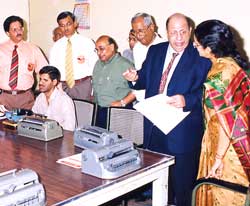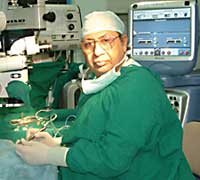‘Father of Indian phaco’ continues to build on legacy of innovation
Click Here to Manage Email Alerts
 Keiki R. Mehta |
When the first phacoemulsification machine was shown at a conference in India, only one ophthalmologist took enough interest to purchase one. As a result, Keiki R. Mehta, MS, came to be known as the “Father of Indian Phacoemulsification.”
“It was painted a dirty gray, and at that moment, I had the thought that I hope it doesn’t turn out to be another gray elephant. Fortunately, it didn’t,” said Dr. Mehta, founder of the Mehta International Eye Institute and the Colaba Eye Hospital.
In an interview with Ocular Surgery News, Dr. Mehta said the risk he took in purchasing the machine came from his belief that it was the application of advanced techniques in ophthalmology that would be the foundation for Indian ophthalmology, a philosophy that defines his career.
“The original concept was that in a Third World country you had to start with the basics. I never accepted that concept,” Dr. Mehta said. “I accepted the concept that in a Third World country you had to have the best equipment to have the maximum turnover while maintaining the highest quality and do so in the shortest surgical time, which is the recipe for success in the rural milieu.”
Introducing the IOL
Dr. Mehta began his work in India in 1971 when he returned from his studies at the Institute of Ophthalmology in London with a collection of IOLs to integrate into Indian ophthalmology.
Despite his confidence in the future of IOLs, Dr. Mehta said his colleagues were not receptive to the idea and tried to discourage him from focusing his energies on them.
“Some people took me aside and told me, ‘you seem to be a sensible sort of guy. Do you really think you should start your career putting in implants?’” Dr. Mehta said. “There was a great deal of skepticism in the beginning, and at least for the first 5 to 6 years, no ophthalmic surgeon put in implants. Fortunately, the patients had more faith in me.”
But reflecting on tales told to him by Sir Harold Ridley, his instructor in London, of the initial skepticism he faced when introducing the idea of the IOL, Dr. Mehta said he was persistent in promoting the lenses to his colleagues in India.
“Despite what anyone had told me, I still thought it was the right thing to do,” he said.
Dr. Mehta continued pioneering the use of IOLs at his newly created Colaba Eye Hospital by introducing the posterior chamber implant into practice and later developing the first soft IOL.
“We started working on doing soft implants in 1976. We started putting in soft implants in humans, and the first paper was presented in December 1977 at the All India Ophthalmological Society and in 1978 in [San Francisco] at the American Intraocular Implant Society,” he said.
His pioneering work with IOLs culminated with the development of the first round IOL, which he implanted for the first time in 1983.
India’s first functional phacoemulsifier
|
Images: Mehta KR |
Dr. Mehta spent the next few years establishing the Colaba Eye Hospital as a center of research and innovative practice through his work with IOLs.
“It’s only after 3 or 4 years that the practice starts to build, and then the news goes around that you are doing these new things. Then the practice rapidly accelerated,” he said.
It was then that Dr. Mehta was presented with the opportunity to introduce phacoemulsification as the next groundbreaking device in India.
According to Dr. Mehta, an Italian company, Opticon, brought a phacoemulsification machine to a conference in India as part of an international tour of the machine.
“We had a conference in 1987 in Bombay, and this was the last day of the conference, and they were going to take it back. Nobody had shown any interest in the machine. It had been around the world, and this was the last stop before it went back to Rome,” he said.
“It was in a bedraggled cardboard case,” when he bought it from them, Dr. Mehta said. “They left it in the drawing room in my house. I asked for a manual. They said there were only four connections. What did I want a manual for?”
He visited the United States and learned the basics from William F. Maloney, MD, in 1988 and “never looked back,” Dr. Mehta said.
Purchasing the machine led to the development of new phaco techniques such as vertical lens rotation, a tangential chop technique involving chopping the lens from a side approach, and lens coring, Dr. Mehta said.
“Most of these techniques were developed and then were shown all over the world and then later caught on. So maybe to some extent we could almost say we did pioneer some things in the world,” he said.
Research activities
In addition to bringing new concepts in ophthalmology to India through the Colaba Eye Hospital, Dr. Mehta worked to expand his clinic. He opened the Mehta International Eye Institute 7 years ago to meet the growing interests of the Colaba Eye Hospital.
“We now felt that we were starting to have formal teaching sessions running on a regular basis and that we were regularizing our research,” Dr. Mehta said. “We now needed to have our own institute.”
Research at the institute has included work with glaucoma valves, primary research into new techniques for retinal management and experimentation with new lenses such as the “clamshell” accommodative lens.
“If we can make it really cheaply and give a good lens that would work and not just stop working after a period of 3 or 4 years after the capsule thickens, then I think we really have something going,” he said.
But Dr. Mehta said it has only been recently that the institute has begun to involve itself in more groundbreaking work, such as stem cell research.
“That has only started since the last 3 to 4 months now, so that is new,” he said. “At present, our work is restricted to limbal stem cells, but we are now gradually expanding our laboratory where we hope to have the whole gamut of research.”
Community service
Dr. Mehta’s latest project has been to expand beyond the institute into the rural areas around Mumbai by setting up the Netra Rukshak Rural Eye Hospital, located in the village of Kadav.
According to Dr. Mehta, the village is in an Adivasi tribal area, which he said is one of the poorest areas in India.
|
|
Although the hospital is a pilot project, Dr. Mehta said the hope is that he and others can develop a satellite model in which the Netra Rukshak Hospital will act as the base, with a series of smaller feeder clinics surrounding it like a cluster.
“In India, we have discovered from experience that 20 kilometers is the maximum a person will ever travel to a hospital,” he said. “You need feeders that will take your patients into the larger better-equipped base hospitals.”
The project is getting limited financial help from local groups as well as from the government, but Dr. Mehta said the hospital must complete 2,500 cataract cases before they can get help from international organizations.
In the meantime, Dr. Mehta has been working to reduce the cost of running the hospital by using phacoemulsification as a basic cataract technique, an idea he says he introduced at an All India Ophthalmological Society meeting a few years after he brought the machine to India.
“I had mentioned in 1991 at a formal symposium in India that it is in rural eye camps that phacoemulsifiers and phacoemulsification techniques would be useful in achieving fast, cheap and high-quality surgery, and I almost got laughed out for it. They literally sneered at me for that, and now you go to any village, and the villagers will ask you, ‘are you going to do this procedure using a stitchless method and a machine? Otherwise, we don’t want you to do it on us,’” Dr. Mehta said.
According to Dr. Mehta, by using phacoemulsification machines in rural hospitals, physicians have been able to eliminate the cost of stitches, as well as the expenses that come with beds, meals and bathroom facilities capable of accommodating 600 to 700 people during overnight stays. “Eye camps have, therefore, become cheaper, easier to do, with better, more predictable results,” he said.
“Our institute always had the viewpoint that it is by utilizing the highest level of expertise and sophistication in equipment and techniques that one can truly benefit the rural sections of India,” he said.
Dr. Mehta continues to push the possibilities of Indian ophthalmology by equipping his hospital with the latest laser and surgical systems, including the Alcon Infiniti Vision System with AquaLase technology, the Accurus vitreoretinal system and the Schwind excimer laser.
In addition, he has incorporated the TeleNet consultation system into his hospital and institute to carry on medical exchanges at an international level.
Through this system, Dr. Mehta and his physicians can send photos of their cases to physicians throughout the world. The group can then discuss the cases, sometimes even using an Internet-based camera.
“Smallpox changes on the cornea are unheard of in the West, whereas we can see them. We get trachoma here, which they probably only read about in textbooks,” he said. “We get an opportunity to exchange concepts and problems, and I think that makes both of us, from our side and from the side of the ones we deal with, far more effective clinicians.”
It is steps such as these that Dr. Mehta hopes will maintain a steady forward progression of Indian ophthalmology toward the latest techniques and innovations.
“If you were to ask what I have achieved, I could say that with my endeavors I have managed to push Indian ophthalmology ahead a little faster than it would have,” he said. “It’s nice to know that you were a catalyst for change; change for the better and have hopefully improved on the quality of life for many.”
For more information:
- Keiki R. Mehta, MBBS, can be reached at Mehta International Eye Institute & Colaba Eye Hospital, Sea Side 147, Shahid Bhagat Singh Road, Mumbai 400005, Maharastra, India; +91-22-215-0082; fax: +91-22-215-0433; e-mail: keiki_mehta@yahoo.com; Web site: mehtaeyeinstitute.com. Dr. Mehta has no financial interest in any of the companies or products mentioned in this article.
Reference:
- Mehta KR, Sathe SN, Karyekar SD. The new soft intraocular implant. J Am Intraocul Implant Soc. 1978;4:200-205.
- Jared Schultz is an OSN Staff Writer who covers all aspects of ophthalmology. He focuses geographically on Europe and the Asia-Pacific region.


